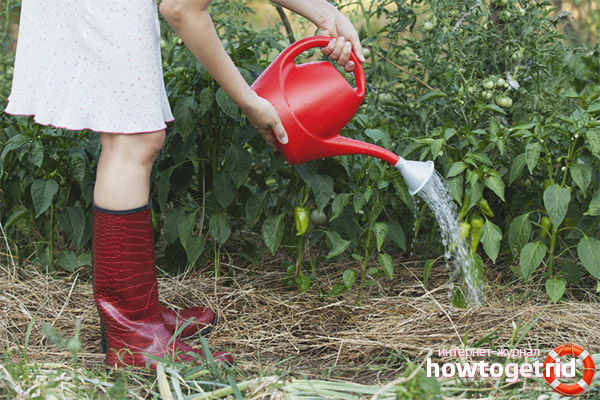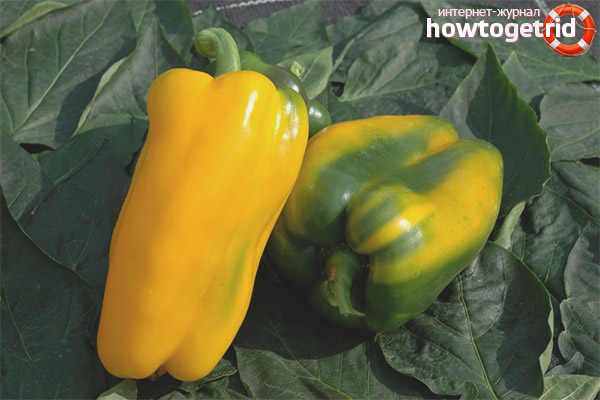The content of the article
Unusual varieties, unpretentious in care, with bright colors, high yield indicators attract the attention of cautious experienced gardeners and amateurs of experiments. Pepper Gemini F1 has already passed both checks, firmly taking its place in the list of popular crops that are in annual demand in the seed market.
Characteristic and Description
Variety bred in Holland. During its selection, emphasis was placed on the viability of the plant, a quick set of fruit mass, and early ripening. In 2007, it was included in the State Register, as recommended for cultivation on an industrial scale. The North Caucasus District is recognized as the optimal production area. Plants are also well acclimatized in the southern and central regions. The peculiarity of the species in its early ripeness. After 2 - 2.5 months, you can take the first fruits. Bushes on average reach 40-50 cm in height, compact, medium and large leaves, dark green, leafyness is small, the root system is well developed.
The fruits are bright yellow in color, ribbed, with thin skin, attached to the bush with a thin peduncle, removed easily, without injuring the plant. Weight on average up to 200 gr. There are smaller ones, in the region of 80 gr., With proper agricultural technology, timely watering and removal of excess ovaries, it is fashionable to obtain individual fruits reaching 300-400 gr. The internal space is divided into 3 chambers, there are few seeds, the wall thickness is 5.6 - 7 mm.
When buying seeds in specialized stores, it retains germination for 3 to 4 years.
Important: It is not recommended to collect planting material from hybrid species on their own, since they do not preserve the initial qualities.
On the bushes from 8 to 11 fruits are tied, the more they are, the smaller they are. For large peppers, leave no more than 5-6 flowers.
Advantages
The hybrid has the main features inherent in early ripe varieties, in addition, it has:
- high productivity;
- disease resistance;
- unpretentiousness to the composition of the soil;
- endurance to temperature changes and humidity indicators;
- great taste;
- prolonged keeping time;
- marketable condition;
- durability and preservation of external data during transportation;
- universality in application.
To achieve maximum performance requires regular feeding and adherence to the irrigation schedule.
disadvantages
According to reviews, there were no special flaws in the variety. Conventionally, they include heterogeneous staining of fruits in the process of achieving full ripeness, exactingness to the balance of potassium, phosphorus and nitrogen in the soil. Garter is necessary when forming large fruits. The heterogeneity of the size of the crop within the same beds.
The subtleties of growing
To obtain a consistently high yield, planting material should be carefully selected. The cost of seeds of hybrid species is usually higher, especially if they are purchased in specialized stores and packaged in bags with double protection. But the advantages of such a purchase are obvious:
- Quality is guaranteed, as large suppliers work with large volumes and protect their business reputation.
- You can purchase bulk packaging, it costs less, and the seeds are planted for 3-4 years without losing their germination.
- All seeds are processed and disinfected.
Timing and landing technology
It takes 60-75 days to seedlings to reach the optimum value for planting in open ground, it is worth another 7-10 days to add for the period of the appearance of the first seedlings. Planting time should be selected taking into account the climatic characteristics of the region, for the Volga region and central regions, preferably mid-February.It is convenient to focus on gardener's calendars and remember that root crops are planted on a waning moon, the green mass is on a growing one. During the new moon, full moon and 1-2 days before these dates, landing work is terminated. With greenhouse cultivation, frost is excluded, so the sowing period can be shifted 1-2 weeks earlier.
You should know: the hybrid is thermophilic, the temperature for germination and the formation of healthy seedlings is maintained within + 2-24 degrees.
Successful seed germination depends on the moisture level and soil composition. It is necessary that it be light, pass air and moisture well, contain certain organic substances. Buying a ready-made soil mixture eliminates the need to compose it yourself, but does not guarantee the subsequent adaptation of pepper when planting it in open ground. Another thing is when the seeds are planted in already prepared soil on the basis of that which will then be on the beds. For cooking, equal parts of humus, turf and earth with fallen leaves are taken, universal fertilizer is added. Before this, the soil mixture is calcined in the oven or spilled with boiling water for disinfection. As a baking powder, sphagnum, sawdust, vermiculite are suitable.
Pepper is sensitive to transplants, often demonstrates a long adaptation, therefore, with small plantings, it is better to sow it immediately in separate cups or peat cells. Then, when planting, the small roots will remain intact. If a mass planting is planned, then the seeds are buried 2 cm. At a distance of 1.5 - 2 cm between the holes. Preservation of humidity is provided with glass or a film. After the first shoots, it is removed.
Seed germination can be accelerated by pre-germination. To do this, take a small plate or saucer, a damp cloth moistened with warm water or a solution of ash containing potassium is placed on it, seeds are laid inside. It will take a few days. After the seeds have nested, they are carefully planted in boxes or cups.
In greenhouses, seedlings are allowed to be planted with 5 to 6 true leaves; in open ground, seedlings of 60-75 days old with a strong stem and a well-formed root system take root better.
A little trick: when planting, pepper does not deepen, but sinks into the soil to the first nodule on the trunk. It will take root better and grow faster, root decay is excluded, their breathing is ensured.
Care and watering

Pepper does not require special agricultural techniques, except for regular feeding and observing the watering regime. It is categorically against an excess of fertilizers, so the recommended dosages should be strictly observed. The first feeding is carried out 2 weeks after germination, then after transplantation to a constant place of growth, then with an interval of 14 days until the formation of the ovary. During the period of fruit growth and ripening, only emergency top dressing with organic fertilizers is possible, but it is better to refrain from it in general, so as not to spoil the taste of the crop.
The alternation of fertilizers and irrigation with a solution of ash or mullein is considered optimal. It is more convenient to use complex preparations sold in gardening stores.
Overdrying and excessive humidity lead to deformation of the trunk, falling leaves, weakening of the root system. It is best to adhere to the regimen once every 4-5 days. In the summer dry season, watering is more frequent. Seedlings require warm, settled water; adult plants are watered on a common basis.
Diseases and Pests
The most malicious pest for pepper is called aphid. A rare season goes without its invasion, hybrids are also subject to its attacks. Spark, Actellik, Fitaverm, Aktara, Lightning, Quadris are used for the fight.
In the process of fruit growth, chemicals are undesirable; they postpone the harvesting period due to their toxicity. It is recommended to use alternative methods, applying water infusions for spraying:
- hot pepper;
- mustard;
- tobacco dust;
- yarrow;
- tansy;
- wormwood.
Gemini F1 early ripe peppers receive excellent reviews every year from homeowners and farmers. It is universal in application, fruits are suitable for fresh use, preservation, are part of winter blanks.
Video: F1 Gemini Peppers










Submit